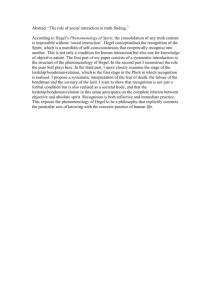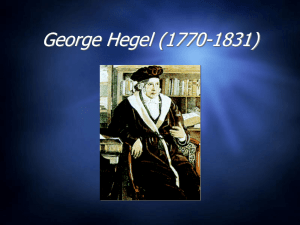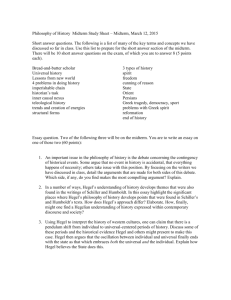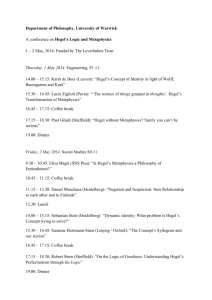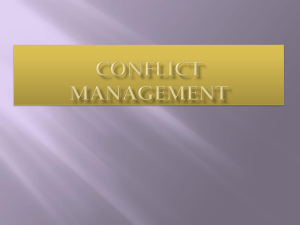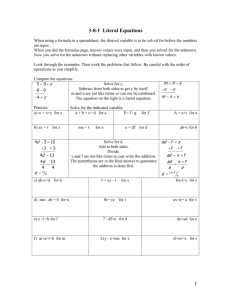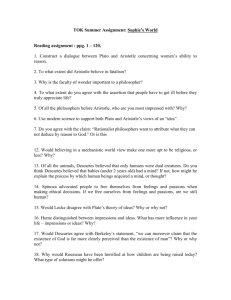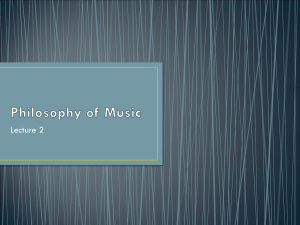Greater Reality Achieved Through Consciousness
advertisement
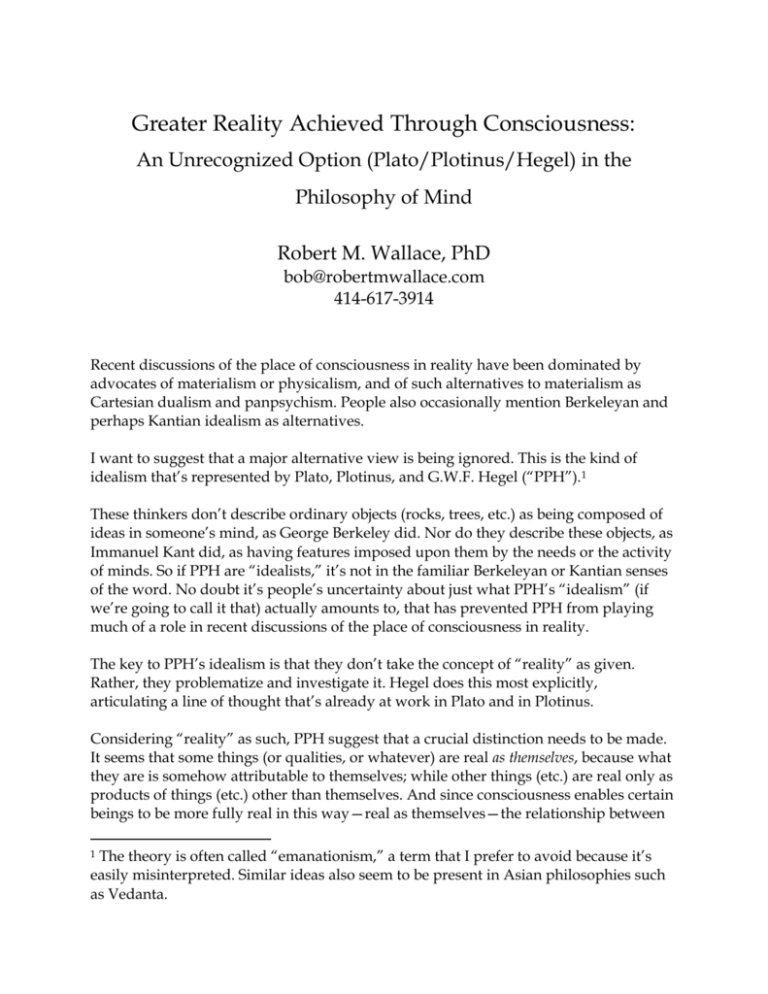
Greater Reality Achieved Through Consciousness: An Unrecognized Option (Plato/Plotinus/Hegel) in the Philosophy of Mind Robert M. Wallace, PhD bob@robertmwallace.com 414-617-3914 Recent discussions of the place of consciousness in reality have been dominated by advocates of materialism or physicalism, and of such alternatives to materialism as Cartesian dualism and panpsychism. People also occasionally mention Berkeleyan and perhaps Kantian idealism as alternatives. I want to suggest that a major alternative view is being ignored. This is the kind of idealism that’s represented by Plato, Plotinus, and G.W.F. Hegel (“PPH”).1 These thinkers don’t describe ordinary objects (rocks, trees, etc.) as being composed of ideas in someone’s mind, as George Berkeley did. Nor do they describe these objects, as Immanuel Kant did, as having features imposed upon them by the needs or the activity of minds. So if PPH are “idealists,” it’s not in the familiar Berkeleyan or Kantian senses of the word. No doubt it’s people’s uncertainty about just what PPH’s “idealism” (if we’re going to call it that) actually amounts to, that has prevented PPH from playing much of a role in recent discussions of the place of consciousness in reality. The key to PPH’s idealism is that they don’t take the concept of “reality” as given. Rather, they problematize and investigate it. Hegel does this most explicitly, articulating a line of thought that’s already at work in Plato and in Plotinus. Considering “reality” as such, PPH suggest that a crucial distinction needs to be made. It seems that some things (or qualities, or whatever) are real as themselves, because what they are is somehow attributable to themselves; while other things (etc.) are real only as products of things (etc.) other than themselves. And since consciousness enables certain beings to be more fully real in this way—real as themselves—the relationship between The theory is often called “emanationism,” a term that I prefer to avoid because it’s easily misinterpreted. Similar ideas also seem to be present in Asian philosophies such as Vedanta. 1 2 reality and consciousness isn’t an external one. The fullest reality is achieved through consciousness. The first thinker who spells out in some detail this relation between full reality and consciousness is Plato. 1. Plato and Plotinus on “Soul” and Oneness For Plato (427-347 BC), the “soul” is something that’s capable of being guided by an ideal Good. This enables it (ideally) to function as “one” in a way that un-souled beings, which have multiple principles of change, cannot. We might take this as suggesting that what’s “one” in this way, being more “itself,” has a kind of reality that other things don’t have. It has reality as itself. A thought of this kind probably underlies Plato’s doctrine that souls, unlike other things that we’re familiar with, are or can be “immortal.” Plato’s famous multiple “Forms” are subordinate to and organized by the single Form of the Good, so their multiplicity doesn’t become a source of confusion and dissipation for individual souls. And the Forms are independent of the world of the senses, so as not to be drawn into that world’s multiplicity and incoherence. Thus the whole doctrine of the Forms seems to be organized around the task of facilitating unity in souls that are guided by them. In contrast to all of the standard views of consciousness (materialism, Berkeleyan idealism, dualism, and panpsychism), Plato’s “idealism” is a “top-down” view. It’s always focused primarily on the higher-level achievement of unity, as opposed to the lower-level ingredients (“physical,” “mental,” whatever they may be) that are processed in that achievement.2 Interpreting Plato, Plotinus (204-270 CE) makes Plato’s organizing interest explicit by identifying the Good as the “One.” Plotinus’s hierarchy of Soul, Intellect and One Lloyd Gerson suggests that this “top-down” structure (as distinct from particular doctrines like that of the Forms) was the defining feature of Platonism in the ancient world. See his “What Is Platonism?” Journal of the History of Philosophy 43 (2005), 253-76. So rather than “Forms” as such, the fundamental idea is that a kind of unity can be achieved that isn’t automatically achieved by physical beings as such. The significance of the Forms is that knowledge of them can contribute to this sort of unity. David Skrbina (Panpsychism in the West [MIT Press, 2005]) cites passages in Plato’s later dialogues and in Plotinus that suggest a commitment to panpsychism: the doctrine that all things have mind or something like it. Plato’s and Plotinus’s works contain a wealth of ideas, among which I doubt that panpsychism is central. In this paper I focus on some of Plato’s and Plotinus’s central ideas that, unlike panpsychism, are not being taken into account in the present-day Anglo-American discussion of mind and reality. 2 3 directs our attention to Plato’s central agenda of the achievement of unity—an agenda from which it’s easy to be distracted by Plato’s ongoing efforts to define the exact status of the Forms, and by Aristotle’s famous critique of those efforts. 2. Hegel on “Reality,” Determinacy, and “Freedom” G.W.F. Hegel (1770-1831) doesn’t adopt Plato’s theory of Forms, as such. But his thinking nevertheless continues to focus, just as Plato’s and Plotinus’s did, on the achievement of unity or self-integration. Hegel’s main term for this unity is “freedom,” which he describes as the ability to be “with oneself in the other.” To be “with oneself” is to have a “self”—to have that kind of unity or freedom. Hegel adds the qualifying clause, “in the other,” to signal that freedom or unity had better not be understood as pertaining to something that excludes others, because something that’s understood as excluding can’t be fully self-defined, and therefore can’t be fully free. With this added point, Hegel intends to resolve an issue that neither Plato nor Plotinus had brought fully into focus. The best way to understand Hegel’s idea is to see how it emerges through the initial moves of his Science of Logic. Here Hegel argues that sheer “being” can’t be distinguished from nothing, so that we must think instead in terms of coming into being or ceasing to be. These promise a determinate content, which being and nothing, as such, both lack. But we have to ask, in virtue of what will this content be determinate? The simplest answer would be for it to be determinate “in itself”; but a competing possibility is that it could be determined by its relations to others. Hegel entitles the first possibility “reality,” Realität, whose Latin root is res or “thing,” so that Realität suggests “thingishness,” or self-sufficiency. It’s important to note that Hegel doesn’t contrast this “reality” with “illusion,” particularly, but rather with a dependence on others. Now the second possibility, that the content is determined by its relation to others, threatens to eliminate self-sufficiency and “thingishness” by creating an infinite regress, whereby each determinacy always depends on something other than itself, which depends on something other than itself, and so forth. But this doesn’t seem to be determinacy at all. To defend the possibility of determinacy against this sort of infinite regress, Hegel invokes the idea of self-determination through an “ought.” We’re familiar, Hegel suggests, with the self-determination that Immanuel Kant described as “autonomy,” in contrast to the other-determination of “heteronomy.” Autonomy is summed up in the “ought” of Kant’s Categorical Imperative. Self-determination through such an “ought” might yield determinacy, Hegel suggests, without infinite regress. This proposal is in effect a restatement of Plato’s proposal that the Soul can be unified if it has a single ideal goal, the Form of the Good. In both Plato’s version and Hegel’s version, the danger of 4 disintegration through multiple influences or relationships is avoided by postulating a single, unifying authority, the “ought” or the Form of the Good. Rather than being alien to the Soul, this authority is in a sense most deeply “within” the Soul. This is because it’s only this authority that makes it possible for the Soul to be fully itself, rather than the product of an endless sequence of things that are other than it. However, Hegel immediately points out that this “ought” is only the germ of a solution to the problem of determinacy, since depending on the “ought” as opposed to depending on “others” appears to depend on the “others” nevertheless. It depends on the others inasmuch as they’re part of the definition of the “ought,” itself, through the relationship described in the previous sentence as “as opposed to.” Kantian “autonomy” is understood not simply as itself, but as the opposite of heteronomy; and something that’s definitionally opposed to something else, isn’t fully self-defining. We might call this the general problem of “dualisms” and pluralisms: that each of the two or the many is supposed to be self-sufficient, but insofar as they’re juxtaposed with one another they have a relationship that prevents any of them from being fully self-sufficient. Hegel’s solution to this problem—his way of retrieving autonomy or self-sufficiency—is to include the “other” within autonomy or (as he calls it) “freedom,” by understanding freedom, as I mentioned, as being “with oneself in the other,” rather than in opposition to the other. Hegel describes autonomy or freedom as “infinity,” because it’s meant to escape the “limits” (the finitude) that make it dependent on other, surrounding beings. This won’t succeed, as we just pointed out, if the supposed “infinity” is limited by its opposition to the finite—if it’s defined simply as the “not-finite.” So a successful infinity, a true infinity, must include the finite, which it can do by being the finite’s surpassing of itself, its going beyond itself, into infinity. The infinite is “with itself in the other,” “in” the finite, when it is the finite’s own going beyond itself into infinity. When autonomy and the “ought” are understood in this way, as a true infinity, they are a true solution of the problem of determinacy. 3. Consequences for Spirit and Nature, Mind and Matter Hegel’s whole philosophical system, in the Science of Logic and the Encyclopedia of the Philosophical Sciences, can be understood as an elaboration of these two moves: the move to the “infinite,” and the move from that to the true infinity. In particular, Hegel presents “Spirit” as infinite in a way that Nature is not, because Spirit aims to be selfdetermining. This is the first move again, the move to the infinite. But to prevent Spirit from being once again limited, this time by its opposition to Nature, and thus failing to be infinite and self-determining, Spirit must be a true infinity, by being Nature’s going beyond itself into self-determination (the second move again). 5 By means of this second move, from simple “infinity” to true infinity, Hegel overcomes the otherwise strong tendency of broadly Platonic thinking to lead its followers into unreconciled dualisms, such as we see (for example) in Gnosticism, in Descartes, and in Kant. Perhaps it was a perception of the need for a true infinity that led Heraclitus (ca. 535-475 BC) to make his famous gnomic remark that “the road up is the road down.” That is (we may interpret) that you can truly “get away” (“upward”) only by immersing yourself (“downward”) in what you’re getting away from. In regard to matter and mind, it’s because of Hegel’s conception of true infinity and his corresponding understanding of Spirit that he is neither a dualist about matter and mind (like Descartes), nor a reductive monist like Hobbes (the materialist) or Berkeley (the “idealist”). Because Hegel’s “Spirit” is the self-surpassing of Nature, Hegel’s Spirit and Nature aren’t simply heterogeneous. Rather they’re intrinsically connected. So Hegel is not a dualist, in the usual sense. Because Spirit is the self-surpassing of Nature, rather than a part of Nature or an epiphenomenon of Nature, Hegel is not a materialist. And because Spirit is the self-surpassing of Nature, which isn’t Spirit, Hegel isn’t a Berkeleyan reductive “idealist,” either. Because for Berkeley, mind is simply the substance of reality. As for the fourth “standard” view, panpsychism: the rudimentary forms of mind that panpsychism imputes to elementary matter presumably don’t include such high achievements as pursuing the True and the Good. So the mixture of mental and material characteristics that panpsychism imputes to all of reality doesn’t achieve what Hegel takes to be full Reality. Spirit is a surpassing of lower forms of being. It’s not a given, but an “achievement.” The great contribution of PPH is this overarching conception of full reality, which embodies features of dualism, materialism, Berkeleyan idealism and panpsychism, while going beyond all of them. Each of these “standard” doctrines brings out an important feature of reality as a whole. Materialism and Berkeleyan idealism both emphasize reality’s unity—that it needs to be intelligible as a coherent whole. Cartesian dualism brings out the heterogeneity of inner and outer, mental and material, to each of which we need to do justice. And panpsychism brings out the need, for the sake of full intelligibility, to unify the heterogeneity of inner and outer, mental and material, without demoting either of them to a mere epiphenomenon of the other. Because of this comprehensiveness, panpsychism is the most nearly adequate of the four standard positions. But it has two weaknesses. The first is that panpsychism’s 6 postulation of “innerness” or mentality in everything has the air of an arbitrary assertion, motivated by theoretical needs rather than by what we observe in less complex entities like atoms and rocks. And the second weakness (Skrbina calls it the “combination” problem) is that panpsychism has trouble explaining how the innerness that it imputes to less complex entities contributes to the innerness that we’re familiar with in more complex entities like ourselves.3 The PPH view is superior to panpsychism in both respects. At the lower end of the scale, PPH don’t impute anything to relatively simple entities that isn’t reflected in their behavior. To the extent that such entities are distinct from their environment, they have a degree of self-determination. There is no need to suppose that they have an inner “feeling” of self-assertion; their distinctness is enough to give them a degree of selfhood. At the other end of the scale, PPH identify a kind of innerness that goes beyond consciousness, namely, the attempt to be guided by what’s truly Good, and thus to live in a way that isn’t dictated by one’s surroundings. It’s not difficult to see how consciousness, sensation, motility, reproduction and growth all contribute to this highest level of self-determination, without constituting it through any kind of aggregation. PPH lay out a scale of kinds of self-determination that are qualitatively different from one another but nested within one another as an increasingly selfdetermining whole. Thus by clarifying the minimal and maximal extremes of self-determination, PPH show why what we’re dealing with in “combination” isn’t aggregation. There is no need to identify a point of demarcation between the absence and the presence of true interiority, because there is no interiority “as such”: self-determination continually changes in character as we proceed up the ladder. And there is no need to explain how elementary units of interiority “add up to” higher-level units. They don’t. Instead, lower-level units contribute what they can contribute to something whose species of self-determination is qualitatively different from what the lower-level units are capable of.4 On panpsychism’s “combination” problem, see Skrbina, index (Leibniz, Clifford, James, Hartshorne, Griffin, Chalmers, Strawson). Galen Strawson, an analytic philosopher who has recently been advocating panpyschism, acknowledges “combination” or “composition” as a serious challenge to the view (Consciousness and Its Place in Nature. Does Physicalism Entail Panpsychism? ed. Anthony Freeman [Charlottesville VA: Imprint Academic, 2006], pp. 248-250, 255-256). 4 The “holism” of Arthur Koestler (The Ghost in the Machine [London: Macmillan, 1967]) and Ken Wilber (Sex, Ecology, Spirituality [Boston: Shambala, 1995]), in which lowerlevel wholes contribute to more inclusive, higher-level wholes, captures some of this stepwise structure that PPH describe. Useful though it is as a counterweight to “atomism,” Koestler’s and Wilber’s focus on “wholes” as such seems to distract them from both the role of the Good, at the highest level, and the underlying theme of selfdetermination, around which PPH construct their ladder. 3 7 What makes the whole sequence intelligible as a sequence isn’t the spatial notions of innerness and outerness and aggregation, as such, but the underlying theme of selfdetermination.5 By identifying and analyzing this underlying theme, PPH’s view integrates the phenomena more effectively than panpsychism or any of the other “standard” views are able to do. 4. Why Should We Take PPH’s Conception of Self-Determining “Reality” Seriously? If we’re accustomed to thinking of reality as epitomized by some given, component “stuff,” whether mental or material or both, then PPH’s notion of full reality as achieved through self-determination seems strange. But there’s a lot to be said for it. First of all, the notion of reality as any kind of “stuff” has little to recommend it other than the fact that it’s familiar and generally unquestioned. And secondly, self-determination is far from being a parochial preoccupation of metaphysicians and German Idealists. Instead, it’s the universal experience of human beings that we try to form opinions and desires that are better justified than the ones that we initially find ourselves with. This is what our processes of dialogue and thought are constantly directed at. And to form opinions and desires that are better justified than the ones that we initially find ourselves with is precisely to make ourselves more self-determining than we were initially. It’s to become more guided by the results of our own thought, and less by what has simply been installed in us or drummed into us by our biological and social antecedents and environment. But to be guided by the results of our own thought rather than merely by our antecedents and environment is precisely to be self-determining. Thus we are intimately familiar with the sort of self-determination or “being real as oneself” to which PPH draw our attention. So we have every reason to take this phenomenon seriously as a key to what might deserve the name of “reality.” It’s true, obviously, that science, which we think of as our main access to what’s “real,” doesn’t in general focus on the kind of “reality” to which PPH draw our attention. Most science employs an unexamined conception of “reality” as something like matter. But a little more self-consciousness on the part of scientists would lead them quickly to realize that the “reality” that PPH focus on is something that scientists are intimately familiar with. This is because opinions that are better justified than the ones that we initially find ourselves with are precisely what science is meant to achieve. And the pursuit of such For a detailed analysis of Hegel’s account of Reality, Nature and Spirit in his Science of Logic and Encyclopedia, see my Hegel’s Philosophy of Reality, Freedom, and God (Cambridge: Cambridge University Press, 2005), chapters 3 and 6, especially sections 6.2 and 6.3. For the structure of Spirit, Hegel is particularly indebted to Aristotle’s De anima, which in turn derives its basic approach from Plato’s Symposium and Timaeus. 5 8 opinions is a major part of human self-determination, and thus a major part of the “reality” that PPH focus on. You may be thinking that PPH’s vertical array of increasing degrees of selfdetermination, from “matter” to Spirit and the One, sounds like what used to be called the “Great Chain of Being” and Plotinus’s “emanationism.” You may also be thinking that today the Great Chain of Being and emanationism are widely treated as curiosities of intellectual history. What I’ve been laying out was certainly the rational insight underlying Plotinus’s emanationism and what came to be called the Great Chain of Being. I’m suggesting that the reason these notions have come to seem antiquated is that the insight underlying them hasn’t been understood, either by their own less penetrating admirers or by historians of ideas and historians of philosophy. 5. The Resulting Status of Consciousness Finally, what does all of this tell us about consciousness, in particular? Like growth, reproduction, motility, sensation, and so forth, consciousness is one of our main ways of making ourselves more self-governing and self-determining. Seen in this context, consciousness is in no way an anomaly or a peculiar mystery. So in that respect, materialism and naturalism, which insist that consciousness should not be an anomaly or a peculiar mystery, are quite correct. Their only mistake is that they ignore the inability of the finite to be fully determinate, and the way in which all of the stages of self-determination serve to overcome that problem, and the sense in which (as a result) Spirit is indeed the most fully real thing. I realize that it’s very much against our normal modern instincts to suppose that something called “Spirit,” even if the term is to be understood in Hegel’s non-dualistic, “true-infinity” way, could be the most fully real thing. So I won’t claim that the PPH view of reality coincides with modern “common sense.” I have three things to say to render its divergence from modern “common sense” palatable. First, PPH don’t deny that nature and matter are quite “real,” in the ordinary sense of the word—that they “exist” and have their qualities independently of our knowing them. They only deny that this existence and possession of qualities are fully “real” in the sense of being fully determinate. And full determinacy is achieved not through our knowing nature and matter, but through our being fully “ourselves” (self-determining), and sharing that self-determination with nature, of which we are a part. What this means is that the PPH view is not anthropocentric in the usual sense, because it makes human mentality constitutive or central not to nature in general, but only to the fullest reality, of which nature is only one aspect. Thus the PPH view doesn’t conflict with common sense in the ways that Berkeley and Kant seem to. 9 Secondly, the great physical theories of the twentieth century, such as relativity theory and quantum mechanics, are universally accepted despite the fact that they diverge from common sense at least as much as PPH do. And finally, PPH’s view of consciousness seems to have the definite advantage over all of the “standard” views of consciousness that it makes coherent sense of all of the phenomena, making none of them “epiphenomenal” and requiring no merely “given” dualism of substances, properties, or aspects. That is, it admirably serves the great scientific goal of parsimonious unification.
